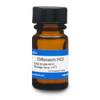Difloxacin HCl is a fluoroquinolone antibiotic commonly used in veterinary medicine. Difloxacin HCl is freely soluble in aqueous solution (5 mg/mL).
| Mechanism of Action | Fluoroquinolone antibiotics target bacterial DNA gyrase, an enzyme which reduces DNA strain during replication. Because DNA gyrase is required during DNA replication, subsequent DNA synthesis and ultimately cell division is inhibited. |
| Spectrum | Difloxacin is a broad spectrum antibiotic targeting a wide variety of Gram negative and Gram positive bacteria. In addition, Difloxacin is also effective against a few Mycoplasma species including Mycobacterium tuberculosis. |
| Microbiology Applications | Difloxacin HCl is commonly used in clinical in vitro microbiological antimicrobial susceptibility tests (panels, discs, and MIC strips) against Gram positive and Gram negative microbial isolates. Medical microbiologists use AST results to recommend antibiotic treatment options for infected patients.Representative MIC values include:
|
| Molecular Formula | C21H19F2N3O3 •HCl |
| References | Wolfson, John S., and David C. Hooper. "The Fluoroquinolones: Structures, Mechanisms of Action and Resistance, and Spectra of Activity in Vitro." American Society for Microbiology 4th ser. 28 (1985): 581-86. |
| MIC | Escherichia coli| 0.1875 - >16|| Mycobacterium tuberculosis| 0.5 - 8|| Staphylococcus aureus| 0.125|| |








